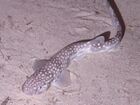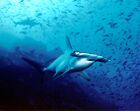Biology:Carcharhiniformes
| Ground sharks | |
|---|---|

| |
| A finetooth shark, Carcharhinus isodon | |
| Scientific classification | |
| Domain: | Eukaryota |
| Kingdom: | Animalia |
| Phylum: | Chordata |
| Class: | Chondrichthyes |
| Subclass: | Elasmobranchii |
| Clade: | Neoselachii |
| Subdivision: | Selachimorpha |
| Superorder: | Galeomorphii |
| Order: | Carcharhiniformes Compagno, 1977 |

Carcharhiniformes /kɑːrkəˈraɪnɪfɔːrmiːz/, the ground sharks, are the largest order of sharks, with over 270 species. They include a number of common types, such as catsharks, swellsharks, and the sandbar shark.
Members of this order are characterized by the presence of a nictitating membrane over the eye, two dorsal fins, an anal fin, and five gill slits.
The families in the order Carcharhiniformes are expected to be revised; recent DNA studies show that some of the conventional groups are not monophyletic.
The oldest members of the order appeared during the Middle-Late Jurassic, which have teeth and body forms that are morphologically similar to living catsharks.[1] Carchariniformes first underwent major diversification during the Late Cretaceous, initially as mostly small-sized forms, before radiating into medium and large body sizes during the Cenozoic.[2][3]
Families
According to FishBase, the nine families of ground sharks are:[4]
- Carcharhinidae (requiem sharks)
- Galeocerdonidae (Tiger shark)
- Hemigaleidae (weasel sharks)
- Leptochariidae (barbeled houndshark)
- Proscylliidae (finback catsharks)
- Pseudotriakidae (false catsharks)
- Scyliorhinidae (catsharks)
- Sphyrnidae (hammerhead sharks)
- Triakidae (houndsharks)
| Family | Image | Common name | Genera | Species | Description |
|---|---|---|---|---|---|
| Carcharhinidae | 
|
Requiem sharks | 11 | 59 | Requiem sharks are migratory, live-bearing sharks of warm seas (sometimes of brackish or fresh water) such as the blue shark, the bull shark, and the milk shark. The usual carcharhiniform characteristics include round eyes and pectoral fins that are completely behind five gill slits. Most species are viviparous, the young being born fully developed. They vary widely in size, from as small as 69 cm (2.26 ft) adult length in the Australian sharpnose shark, up to 4 m (13 ft) adult length in the oceanic whitetip shark.[5] Requiem sharks are responsible for a large proportion of attacks on humans. |
| †Florenceodontidae?[6] | 1 | 1 | Extinct | ||
| Galeocerdonidae | 
|
Tiger shark | 1 | 1 extant | A formerly diverse genus, only one species exists today. The tiger shark is the largest member of this order |
| Hemigaleidae | Weasel sharks | 4 | 8 | Weasel sharks are found from the eastern Atlantic Ocean to the continental Indo-Pacific in shallow coastal waters to a depth of 100 m (330 ft).[7] Most species are small, reaching no more than 1.4 m long (4.6 ft), though the snaggletooth shark (Hemipristis elongatus) may reach 2.4 m (7.9 ft). They have horizontally oval eyes, small spiracles, and precaudal pits. Two dorsal fins occur, with the base of the first placed well forward of the pelvic fins. The caudal fin has a strong ventral lobe and undulations on the dorsal lobe margin. They feed on a variety of small bony fishes and invertebrates; at least two species specialize on cephalopods. They are not known to have attacked people.[8] | |
| Leptochariidae | 
|
Barbeled houndsharks | 1 | 1 | The only species of barbeled houndshark is Leptocharias smithii. It is a demersal species found in the coastal waters of the eastern Atlantic Ocean from Mauritania to Angola, at depths of 10–75 m (33–246 ft). It favours muddy habitats, particularly around river mouths. The barbeled houndshark is characterized by a very slender body, nasal barbels, long furrows at the corners of the mouth, and sexually dimorphic teeth. Its maximum known length is 82 cm (32 in). Likely strong-swimming and opportunistic, the barbeled houndshark has been known to ingest bony fishes, invertebrates, fish eggs, and even inedible objects. It is viviparous, with females bearing litters of seven young; the developing embryos are sustained by a unique globular placental structure. The IUCN has assessed the barbeled houndshark as near threatened, as heavy fishing pressure occurs throughout its range and it is used for meat and leather. |
| Proscylliidae | 
|
Finback catsharks | 3 | 7 | |
| Pseudotriakidae | False catsharks | 3 | 5 | False catsharks are a small family containing false catsharks and gollumsharks. It contains the only ground shark species to exhibit intrauterine oophagy, in which developing fetuses are nourished by eggs produced by their mother.[9] | |
| †Pseudoscyliorhinidae[1] | 2 | 3 | Extinct | ||
| Scyliorhinidae | 
|
Catsharks | 17 | >150 | Catsharks are distinguished by their elongated, cat-like eyes and two small dorsal fins set far back. They usually have a patterned appearance, ranging from stripes to patches to spots. Most are fairly small, growing no longer than 80 cm (31 in); a few, such as the nursehound, can reach 1.6 m (5.2 ft) in length. They are found in temperate and tropical seas worldwide, ranging from shallow intertidal waters to depths of 2,000 m (6,600 ft) or more, depending on species.[10] They feed on invertebrates and smaller fish. Some species are aplacental viviparous, but most lay eggs in tough egg cases with curly tendrils at each end, known as mermaid's purses. The swell sharks of the genus Cephaloscyllium fill their stomachs with water or air when threatened, increasing their girth by a factor of two to three. Some catsharks are called dogfish. |
| Sphyrnidae | 
|
Hammerhead sharks | 2 | 9 | Hammerhead sharks are named for the unusual and distinctive structure of their heads, which are flattened and laterally extended into a "hammer" shape called a cephalofoil. Many, not necessarily mutually exclusive, functions have been proposed for the cephalofoil, including sensory reception, manoeuvring, and prey manipulation. Hammerheads are found worldwide in warmer waters along coastlines and continental shelves. Unlike most sharks, hammerheads usually swim in schools during the day, becoming solitary hunters at night. |
| Triakidae | 
|
Houndsharks | 9 | 40 | Houndsharks are distinguished by large spineless dorsal fins, an anal fin, and oval eyes with nictitating eyelids. They are small to medium in size, ranging from 37 to 220 cm (1.21 to 7.22 ft) in adult length. They are found throughout the world in warm and temperate waters, where they feed on fish and invertebrates on the sea bed and in midwater.[11] |
Timeline of genera
<timeline> ImageSize = width:1000px height:auto barincrement:15px PlotArea = left:10px bottom:50px top:10px right:10px
Period = from:-199.6 till:15 TimeAxis = orientation:horizontal ScaleMajor = unit:year increment:10 start:-199.6 ScaleMinor = unit:year increment:1 start:-199.6 TimeAxis = orientation:hor AlignBars = justify
Colors =
#legends id:CAR value:claret id:ANK value:rgb(0.4,0.3,0.196) id:HER value:teal id:HAD value:green id:OMN value:blue id:black value:black id:white value:white id:mesozoic value:rgb(0.54,0.54,0.258) id:jurassic value:rgb(0.2,0.7,0.79) id:earlyjurassic value:rgb(0,0.69,0.89) id:middlejurassic value:rgb(0.52,0.81,0.91) id:latejurassic value:rgb(0.74,0.89,0.97) id:cretaceous value:rgb(0.5,0.78,0.31) id:earlycretaceous value:rgb(0.63,0.78,0.65) id:latecretaceous value:rgb(0.74,0.82,0.37) id:cenozoic value:rgb(0.54,0.54,0.258) id:paleogene value:rgb(0.99,0.6,0.32) id:paleocene value:rgb(0.99,0.65,0.37) id:eocene value:rgb(0.99,0.71,0.42) id:oligocene value:rgb(0.99,0.75,0.48) id:neogene value:rgb(0.999999,0.9,0.1) id:miocene value:rgb(0.999999,0.999999,0) id:pliocene value:rgb(0.97,0.98,0.68) id:quaternary value:rgb(0.98,0.98,0.5) id:pleistocene value:rgb(0.999999,0.95,0.68) id:holocene value:rgb(0.999,0.95,0.88)
BarData=
bar:eratop bar:space bar:periodtop bar:space bar:NAM1 bar:NAM2 bar:NAM3 bar:NAM4 bar:NAM5 bar:NAM6 bar:NAM7 bar:NAM8 bar:NAM9 bar:NAM10 bar:NAM11 bar:NAM12 bar:NAM13 bar:NAM14 bar:NAM15 bar:NAM16 bar:NAM17 bar:NAM18 bar:NAM19 bar:NAM20 bar:NAM21 bar:NAM22 bar:NAM23 bar:NAM24 bar:NAM25 bar:NAM26 bar:NAM27
bar:space bar:period bar:space bar:era
PlotData=
align:center textcolor:black fontsize:M mark:(line,black) width:25 shift:(7,-4) bar:periodtop from: -199.6 till: -175.6 color:earlyjurassic text:Early from: -175.6 till: -161.2 color:middlejurassic text:Middle from: -161.2 till: -145.5 color:latejurassic text:Late from: -145.5 till: -99.6 color:earlycretaceous text:Early from: -99.6 till: -65.5 color:latecretaceous text:Late from: -65.5 till: -55.8 color:paleocene text:Paleo. from: -55.8 till: -33.9 color:eocene text:Eo. from: -33.9 till: -23.03 color:oligocene text:Oligo. from: -23.03 till: -5.332 color:miocene text:Mio. from: -5.332 till: -2.588 color:pliocene text:Pl. from: -2.588 till: -0.0117 color:pleistocene text:Pl. from: -0.0117 till: 0 color:holocene text:H.
bar:eratop from: -199.6 till: -145.5 color:jurassic text:Jurassic from: -145.5 till: -65.5 color:cretaceous text:Cretaceous from: -65.5 till: -23.03 color:paleogene text:Paleogene from: -23.03 till: -2.588 color:neogene text:Neogene from: -2.588 till: 0 color:quaternary text:Q.
PlotData=
align:left fontsize:M mark:(line,white) width:5 anchor:till align:left
color:latejurassic bar:NAM1 from:-152.57 till:-150.8 text:Macrourogaleus color:earlycretaceous bar:NAM2 from:-103.7 till:0 text:Scyliorhinus color:latecretaceous bar:NAM3 from:-93.5 till:-89.3 text:Pterolamiops color:latecretaceous bar:NAM4 from:-93.5 till:-70.6 text:Paratriakis color:latecretaceous bar:NAM5 from:-84.27 till:-65.5 text:Pteroscyllium color:latecretaceous bar:NAM6 from:-83.5 till:-70.6 text:Archaeotriakis color:latecretaceous bar:NAM7 from:-83.5 till:-58.7 text:Palaeogaleus color:latecretaceous bar:NAM8 from:-74.9 till:-68.9 text:Squatigaleus color:paleocene bar:NAM9 from:-65.5 till:-33.9 text:Abdounia color:paleocene bar:NAM10 from:-65.5 till:0 text:Triakis color:paleocene bar:NAM11 from:-56.0 till:-15.97 text:Physogaleus color:eocene bar:NAM12 from:-55.8 till:-48.6 text:Pachygaleus color:eocene bar:NAM13 from:-55.8 till:-48.6 text:Premontreia color:eocene bar:NAM14 from:-55.8 till:-37.2 text:Eogaleus color:eocene bar:NAM15 from:-55.8 till:0 text:Carcharhinus color:eocene bar:NAM16 from:-55.8 till:0 text:Galeocerdo color:eocene bar:NAM17 from:-55.8 till:0 text:Hemipristis color:eocene bar:NAM18 from:-55.8 till:0 text:Isogomphodon color:eocene bar:NAM19 from:-55.8 till:-0.0117 text:Megascyliorhinus color:eocene bar:NAM20 from:-55.8 till:0 text:Mustelus color:eocene bar:NAM21 from:-55.8 till:0 text:Rhizoprionodon color:eocene bar:NAM22 from:-48.6 till:0 text:Negaprion color:miocene bar:NAM23 from:-23.03 till:0 text:Chaenogaleus color:miocene bar:NAM24 from:-23.03 till:0 text:Galeorhinus color:miocene bar:NAM25 from:-23.03 till:0 text:Paragaleus color:miocene bar:NAM26 from:-15.97 till:0 text:Sphyrna color:pliocene bar:NAM27 from:-5.332 till:0 text:Prionace
PlotData=
align:center textcolor:black fontsize:M mark:(line,black) width:25
bar:period from: -199.6 till: -175.6 color:earlyjurassic text:Early from: -175.6 till: -161.2 color:middlejurassic text:Middle from: -161.2 till: -145.5 color:latejurassic text:Late from: -145.5 till: -99.6 color:earlycretaceous text:Early from: -99.6 till: -65.5 color:latecretaceous text:Late from: -65.5 till: -55.8 color:paleocene text:Paleo. from: -55.8 till: -33.9 color:eocene text:Eo. from: -33.9 till: -23.03 color:oligocene text:Oligo. from: -23.03 till: -5.332 color:miocene text:Mio. from: -5.332 till: -2.588 color:pliocene text:Pl. from: -2.588 till: -0.0117 color:pleistocene text:Pl. from: -0.0117 till: 0 color:holocene text:H.
bar:era from: -199.6 till: -145.5 color:jurassic text:Jurassic from: -145.5 till: -65.5 color:cretaceous text:Cretaceous from: -65.5 till: -23.03 color:paleogene text:Paleogene from: -23.03 till: -2.588 color:neogene text:Neogene from: -2.588 till: 0 color:quaternary text:Q.
</timeline>
References
- ↑ 1.0 1.1 Stumpf, Sebastian; Scheer, Udo; Kriwet, Jürgen (2019-03-04). "A new genus and species of extinct ground shark, †Diprosopovenator hilperti, gen. et sp. nov. (Carcharhiniformes, †Pseudoscyliorhinidae, fam. nov.), from the Upper Cretaceous of Germany". Journal of Vertebrate Paleontology 39 (2): e1593185. doi:10.1080/02724634.2019.1593185. ISSN 0272-4634. Bibcode: 2019JVPal..39E3185S.
- ↑ Condamine, Fabien L.; Romieu, Jules; Guinot, Guillaume (2019-10-08). "Climate cooling and clade competition likely drove the decline of lamniform sharks" (in en). Proceedings of the National Academy of Sciences 116 (41): 20584–20590. doi:10.1073/pnas.1902693116. ISSN 0027-8424. PMID 31548392. Bibcode: 2019PNAS..11620584C.
- ↑ Brée, Baptiste; Condamine, Fabien L.; Guinot, Guillaume (2022-12-19). "Combining palaeontological and neontological data shows a delayed diversification burst of carcharhiniform sharks likely mediated by environmental change" (in en). Scientific Reports 12 (1): 21906. doi:10.1038/s41598-022-26010-7. ISSN 2045-2322. PMID 36535995. Bibcode: 2022NatSR..1221906B.
- ↑ Fish Identification: Ground sharks FishBase. Retrieved 28 March 2013.
- ↑ Compagno, L.J.V. Family Carcharhinidae - Requiem sharks in Froese, R. and D. Pauly. Editors. 2010. FishBase. World Wide Web electronic publication, version (05/2010).
- ↑ Cappetta, Henri; Morrison, Kurt; Adnet, Sylvain (2019-12-10). "A shark fauna from the Campanian of Hornby Island, British Columbia, Canada: an insight into the diversity of Cretaceous deep-water assemblages". Historical Biology 33 (8): 1121–1182. doi:10.1080/08912963.2019.1681421. ISSN 0891-2963. http://dx.doi.org/10.1080/08912963.2019.1681421.
- ↑ Froese, Rainer, and Daniel Pauly, eds. (2011). "Hemigaleidae" in FishBase. February 2011 version.
- ↑ Compagno, Leonard J. V. (1984) Sharks of the World: An Annotated and Illustrated Catalogue of Shark Species Known to Date. Rome: Food and Agriculture Organization. ISBN:92-5-101384-5.
- ↑ Froese, Rainer, and Daniel Pauly, eds. (2012). "Pseudotriakidae" in FishBase. December 2012 version.
- ↑ Froese, Rainer, and Daniel Pauly, eds. (2009). "Scyliorhinidae" in FishBase. January 2009 version.
- ↑ Froese, Rainer, and Daniel Pauly, eds. (2009). "Triakidae" in FishBase. January 2009 version.
Further reading
- Froese, Rainer, and Daniel Pauly, eds. (2013) Fish Identification: Ground sharks in FishBase. March 2013 version.
- Sepkoski, Jack (2002). "A compendium of fossil marine animal genera". Bulletins of American Paleontology 364: 560. http://strata.ummp.lsa.umich.edu/jack/showgenera.php?taxon=575&rank=class. Retrieved 2011-05-17.
External links
Wikidata ☰ Q48178 entry
 |

